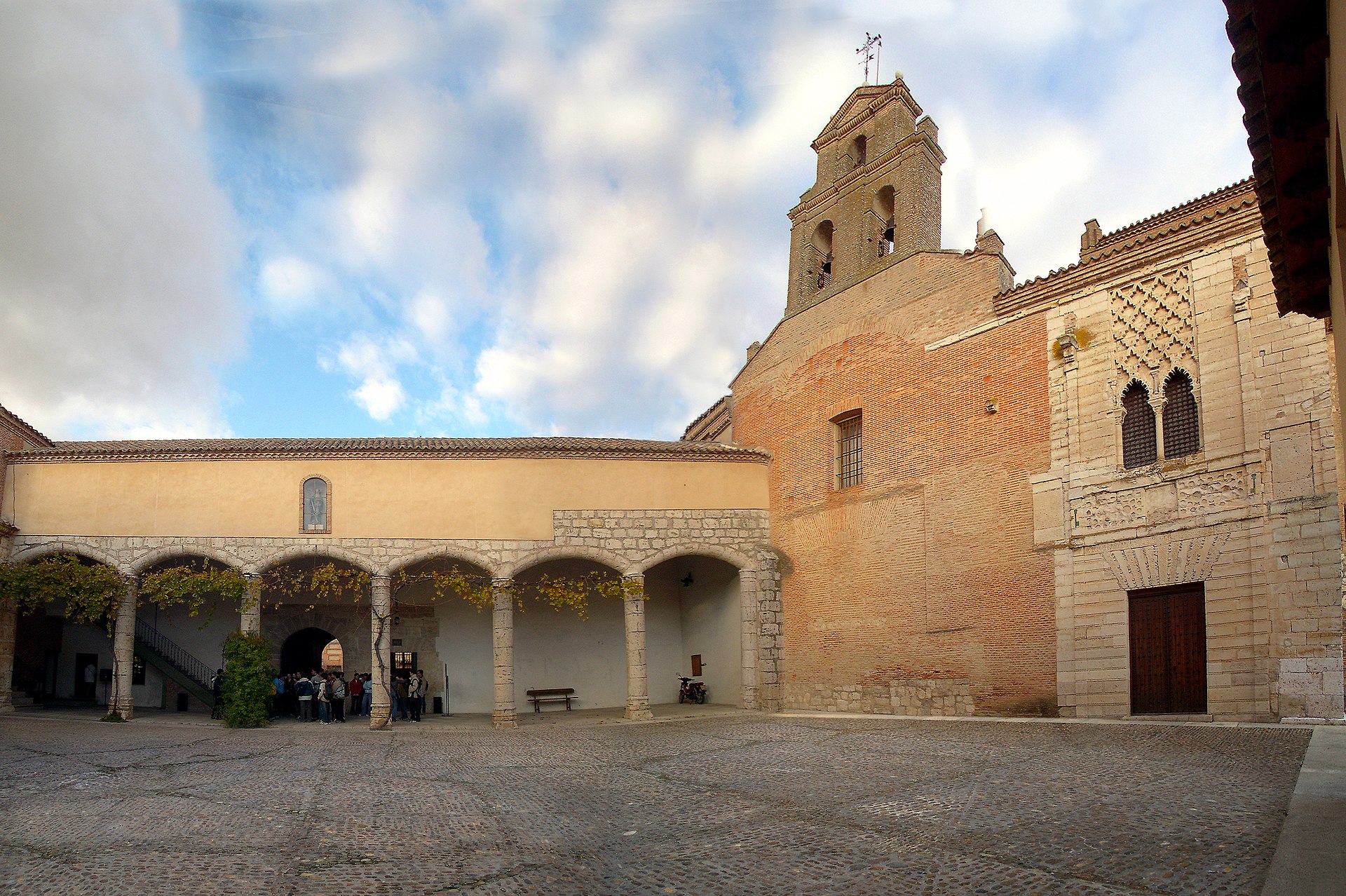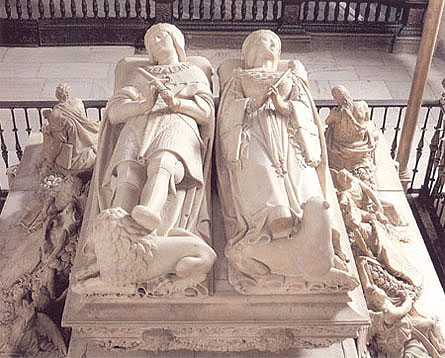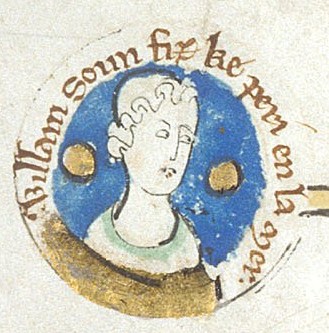by Susan Flantzer
© Unofficial Royalty 2022

Juana I, Queen of Castile and León and Queen of Aragon; Credit – Wikipedia
Juana I, Queen of Castile and León and Queen of Aragon was born on November 6, 1479, in Toledo, Kingdom of Castile, now in Spain. She was the third of the five children and the second of the four daughters of Ferdinand II, King of Aragon and Isabella I, Queen of Castile and León. Juana’s paternal grandparents were Juan II, King of Aragon and his second wife Juana Enriquez, 5th Lady of Casarrubios del Monte. Her maternal grandparents were Juan II, King of Castile and León and his second wife Isabel of Portugal.

Juana with her parents Ferdinand and Isabella; Credit – Wikipedia
Juana had four siblings:
- Isabella of Aragon, Princess of Asturias from 1497–1498 (1470 – 1498), married (1) Prince Afonso of Portugal, no children (2) Prince Manuel, the future King Manuel I of Portugal, had one son Miguel da Paz, Crown Prince of both Portugal and Spain who died before his second birthday; Isabella died giving birth to Miguel
- Juan of Aragon, Prince of Asturias (1478 – 1497), married Margaret of Austria, no children
- Maria of Aragon (1482 – 1517), married King Manuel I of Portugal, the widower of her elder sister Isabella; had ten children including King João III of Portugal and Cardinal-King Henrique I of Portugal
- Catalina (Catherine) of Aragon (1485 – 1536), married (1) Arthur, Prince of Wales, no children (2) Arthur’s younger brother King Henry VIII of England, had one surviving child Queen Mary I of England

Juana in her teenage years; Credit – Wikipedia
Like her mother Isabella, Queen of Castile and León and her youngest sister Catalina (Catherine of Aragon, the first wife of King Henry VIII of England), Juana had a fair complexion and golden-red hair which had come from her mother’s descent from the English House of Plantagenet. Isabella’s paternal grandmother was Catherine of Lancaster, the daughter of John of Gaunt, 1st Duke of Lancaster who was the son of King Edward III of England. As an infanta (princess), Juana was not expected to inherit either of her parent’s thrones although, through deaths, she inherited both. Her education reflected the fact that she was an unlikely heir. Juana had a general education, studying church and civil law, genealogy and heraldry, grammar, history, languages, and mathematics.

Philip of Austria, Juana’s husband; Credit – Wikipedia
In 1496, 16-year-old Juana was betrothed to 18-year-old Philip of Austria, often called Philip of Habsburg or Philip the Handsome. He was the only son of Mary, Duchess of Burgundy in her own right, the ruler of a collection of states known as the Burgundian State, and Maximilian I, Holy Roman Emperor, Archduke of Austria. When Philip was four years old, his mother died in a riding accident, and Philip succeeded her as ruler of the Burgundian State which consisted of parts of the present-day Netherlands, Belgium, Luxembourg, France, and Germany.
Philip’s father Maximilian I, made an alliance with the husband and with Juana’s parents King Ferdinand II of Aragon and Queen Isabella I of Castile and León, for a double marriage between their children. Juan, Prince of Asturias, the only son and heir of Ferdinand and Isabella, would marry Maximilian’s only daughter Margaret of Austria, and Ferdinand and Isabella’s second daughter Infanta Juana of Castile would marry Maximilian’s only son Philip. These marriages were part of the foreign policy of Ferdinand and Isabella to build a network of alliances through the marriages of their children to strengthen their kingdoms, destined to be inherited by their son Juan, against France, their major rival at that time. The double marriages were never intended to allow the Spanish kingdoms to fall under the control of the House of Habsburg, which they eventually did. Juana was third in line to the thrones of Aragon, Castile, and León after her elder brother Juan and her elder sister Isabella, and would fall further down the line of succession when her elder siblings had children, as was expected.
Juana and Philip were married by proxy at the Palacio de los Vivero in Valladolid, Kingdom of Castile. On August 22, 1496, Juana began her journey to her new home. The wedding was formally celebrated on October 20, 1496, at the Collegiate Church of Saint Gummarus in the small town of Lier, now in Belgium, near the city of Antwerp.

The three eldest children of Juana and Philip: Eleanor, Carlos, and Isabella; Credit – Wikipedia
Juana and Philip had six children, all of whom were kings or queen consorts:
- Eleanor of Austria, Queen of Portugal, Queen of France (1498 – 1558), married (1) Manuel I, King of Portugal (his third wife), had two children (2) François I, King of France (his second wife), no children
- Charles V, Holy Roman Emperor, also Carlos I, King of Spain (1500 – 1558), married Isabella of Portugal, had five children including Felipe II, King of Spain
- Isabella of Austria, Queen of Denmark, Norway, and Sweden (1501 – 1526), married Christian II, King of Denmark, Norway, and Sweden, had five children, only two daughters survived childhood
- Ferdinand I, Holy Roman Emperor, (1503 – 1564), married Anna of Bohemia and Hungary, had fifteen children
- Mary of Austria, Queen of Bohemia and Hungary, Governor of the Spanish Netherlands (1505 – 1558), married Louis II, King of Hungary, Croatia and Bohemia, no children
- Catherine of Austria, Queen of Portugal (1507 – 1578), married João III, King of Portugal, had nine children
Within four years of her marriage to Philip, Juana became the heir to her parents’ kingdoms after the death of her childless only brother Juan, Prince of Asturias in 1497, the death of her eldest sister Isabella of Aragon, Princess of Asturias, Princess of Portugal in childbirth in 1498, and the death of her sister Isabella’s only child Prince Miguel da Paz of Portugal in 1500, shortly before his second birthday.
Although Juana was deeply in love with Philip, their married life was unhappy. Philip was unfaithful and politically insecure. He constantly attempted to usurp Juana’s legal birthrights. This led to the rumors of Juana’s insanity because those rumors benefited Philip politically. Most historians now agree Juana was clinically depressed and not insane as commonly believed.
On November 26, 1504, Isabella I, Queen of Castile and León died at the age of 53. Juana became Queen of Castile and León but her father Ferdinand II, King of Aragon proclaimed himself Governor and Administrator of Castile and León. In 1506, Juana’s husband Philip of Austria became King of Castile and León jure uxoris (by the right of his wife) as Philip I, initiating the rule of the Habsburgs in the Spanish kingdoms which would last until 1700. However, Philip’s rule lasted only from July 12, 1506 to September 25, 1506, when he died suddenly, apparently of typhoid fever, although an assassination by poisoning was rumored at the time.

A 19th-century painting of Juana holding vigil over Philip’s coffin by Francisco Pradilla Ortiz, 1877; Credit – Wikipedia
There were also rumors circulating about the supposed madness of Juana. Unfortunately, Juana’s husband Philip had spread rumors about her madness when he was still alive and her behavior after his death may have reinforced these rumors. Juana decided to transfer Philip’s remains from Burgos in the north of present-day Spain, where he had died and had already been buried, to Granada in the south of present-day Spain. Apparently, Philip wanted to be buried in Granada. The distance from Burgos to Granada is 423 miles/681 kilometers, a 6 1/2 hour car ride today, but an extraordinary distance in 1506. Pregnant with her last child, Juana traveled with her husband’s body from Burgos to Granada. The trip would take eight months. During the trip, Juana gave birth to her last child named Catherine after her youngest sister, Catherine of Aragon, the first wife of King Henry VIII of England.

Royal Convent of Santa Clara in Tordesillas, Kingdom of Castile where Juana was confined for forty-six years; Credit – By José-Manuel Benito – Own work, Public Domain, https://commons.wikimedia.org/w/index.php?curid=519592
In 1509, Juana’s father Ferdinand convinced the parliament that Juana was too mentally ill to govern, and was appointed her guardian and regent of Castile and León. Juana was confined in the Royal Convent of Santa Clara in Tordesillas, Kingdom of Castile, under the orders of her father. Juana’s youngest child Catherine stayed with her mother at the convent until 1525, when she was released from the custody that her mother was to endure until her death in 1555.
Was Juana mad or was she manipulated by her father, husband, and son? Juana’s father Ferdinand, her husband Philip, and her son Carlos had a lot to gain from Juana being declared unfit to rule. Juana did show excessive grief as she traveled through Castile with Philip’s coffin. What is overlooked is that her 28-year-old husband died suddenly after a five-day illness and that she was fulfilling Philip’s wish to be buried in Granada. In addition, her father deliberately blocked Philip’s burial in Granada causing delays in Juana’s journey.
On January 23, 1516, Ferdinand II, King of Aragon died. In his will, Ferdinand named his daughter Juana and her eldest son Carlos (also known as Charles in history) as the co-heirs of the Kingdom of Aragon. However, Juana would never reign as she would not be released from her confinement until her death.

Juana’s son Carlos; Credit – Wikipedia
It would be her son Carlos who would reign. Carlos would inherit the dominions of his mother Juana (Castile, León, and Aragon), the dominions of his father Philip (the Burgundian State which were parts of the present-day Netherlands, Belgium, Luxembourg, France, and Germany), and also the dominions of his paternal grandfather Maximilian I, Archduke of Austria, Duke of Styria, Carinthia, and Carniola, and Holy Roman Emperor who died after his father Philip’s death. When Juana died in 1555, it resulted in the personal union of Spain and the Holy Roman Empire, as her son Charles V, Holy Roman Emperor, among many other titles, also became King of Castile and León, and Aragon, effectively creating the Kingdom of Spain. Carlos I was not only the first King of a united Spain and Charles V, Holy Roman Emperor, but he was also Charles I, Archduke of Austria, and Charles II, Lord of the Netherlands, among many other titles.

Tomb of Philip and Juana; Credit – By Javi Guerra Hernando – Own work, CC BY-SA 4.0, https://commons.wikimedia.org/w/index.php?curid=35974698
Juana spent forty-six years basically imprisoned. Decades of internment, isolation, and sometimes inhumane treatment by her guards had serious negative effects on her. Juana, Queen of Castile and León and Queen of Aragon died on April 12, 1555, aged 75, at the Royal Convent of Santa Clara in Tordesillas, Castile, now in Spain. She was buried with her parents and husband at the Royal Chapel of Granada, now in Spain.

Royal Chapel of Granada in 1850, drawing by Francesc Xavier Parceris; Credit – Wikipedia
This article is the intellectual property of Unofficial Royalty and is NOT TO BE COPIED, EDITED, OR POSTED IN ANY FORM ON ANOTHER WEBSITE under any circumstances. It is permissible to use a link that directs to Unofficial Royalty.
Works Cited
- En.wikipedia.org. 2022. Joanna of Castile – Wikipedia. [online] Available at: <https://en.wikipedia.org/wiki/Joanna_of_Castile> [Accessed 17 July 2022].
- En.wikipedia.org. 2022. Philip I of Castile – Wikipedia. [online] Available at: <https://en.wikipedia.org/wiki/Philip_I_of_Castile> [Accessed 17 July 2022].
- Es.wikipedia.org. 2022. Felipe I de Castilla – Wikipedia, la enciclopedia libre. [online] Available at: <https://es.wikipedia.org/wiki/Felipe_I_de_Castilla> [Accessed 17 July 2022].
- Es.wikipedia.org. 2022. Juana I de Castilla – Wikipedia, la enciclopedia libre. [online] Available at: <https://es.wikipedia.org/wiki/Juana_I_de_Castilla> [Accessed 17 July 2022].
- Flantzer, Susan, 2022. Ferdinand II, King of Aragon, King of Castile and León. [online] Unofficial Royalty. Available at: <https://www.unofficialroyalty.com/ferdinand-ii-king-of-aragon-king-of-castile-and-leon/> [Accessed 16 July 2022].
- Flantzer, Susan, 2022. Isabella I, Queen of Castile and León, Queen of Aragon. [online] Unofficial Royalty. Available at: <https://www.unofficialroyalty.com/isabella-i-queen-of-castile-and-leon-queen-of-aragon/> [Accessed 16 July 2022].






























